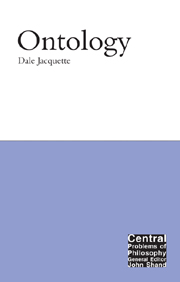Book contents
- Frontmatter
- Contents
- Preface
- Acknowledgements
- Introduction: Being as such
- I Pure philosophical ontology
- II Applied ontology and the metaphysics of science
- 6 Ontological commitment (on Quine)
- 7 Appearance, reality, substance, transcendence
- 8 Physical entities: space, time, matter and causation, physical states of affairs and events, natural laws
- 9 Abstract entities, particular and universal: numbers, sets, properties, qualities, relations, propositions and possibilities, logical, mathematical and metaphysical laws
- 10 Subjectivity of mind in the world of objective physical facts
- 11 God, a divine supernatural mind?
- 12 Ontology of culture: language, art and artefacts
- Conclusion: scientific–philosophical ontology
- Notes
- Bibliography
- Index
7 - Appearance, reality, substance, transcendence
from II - Applied ontology and the metaphysics of science
- Frontmatter
- Contents
- Preface
- Acknowledgements
- Introduction: Being as such
- I Pure philosophical ontology
- II Applied ontology and the metaphysics of science
- 6 Ontological commitment (on Quine)
- 7 Appearance, reality, substance, transcendence
- 8 Physical entities: space, time, matter and causation, physical states of affairs and events, natural laws
- 9 Abstract entities, particular and universal: numbers, sets, properties, qualities, relations, propositions and possibilities, logical, mathematical and metaphysical laws
- 10 Subjectivity of mind in the world of objective physical facts
- 11 God, a divine supernatural mind?
- 12 Ontology of culture: language, art and artefacts
- Conclusion: scientific–philosophical ontology
- Notes
- Bibliography
- Index
Summary
Scientific ontology
We now consider the first of a series of ontological commitments in four traditional subscategories of applied scientific ontology. Shall we follow the lead of other ontologists by distinguishing between appearance and reality in a strong metaphysical sense? What shall we say about the ontology of substance? Is there an argument to be made for the transcendence of a certain part of the preferred existence domain that is, in some sense, above and beyond, or in any case outside, the actual world? What light does the combinatorial analysis of being as maximal consistency shed on any of these time-honoured distinctions in metaphysics and applied scientific ontology?
Applied scientific ontology is not the pure philosophical ontology of being qua being but, so to speak, an annotated inventory of entities, in which we offer good reasons for saying yes or no to including contested entities in a preferred existence domain. It is here that we try to identify the ultimate kinds or categories of existent entities that we need, not only for science but for all meaningful thought. In contrast with physical objects and physical states of affairs, we may find it necessary to require convincing philosophical arguments to satisfy natural scepticism about the existence of putative entities that we do not directly experience in sensation, such as abstract entities, especially numbers and universals, propositions, minds and God. The same might also be true for the concepts of imperceptible substance and transcendent entities.
- Type
- Chapter
- Information
- Ontology , pp. 182 - 192Publisher: Acumen PublishingPrint publication year: 2002



